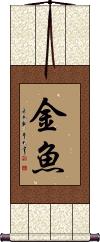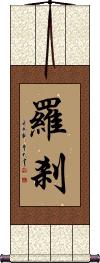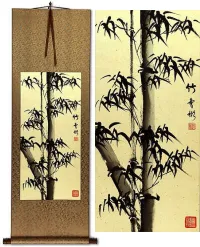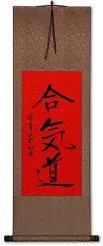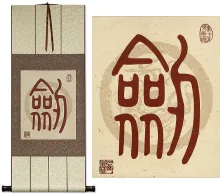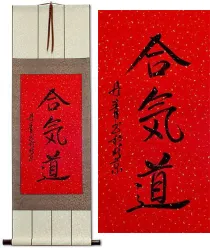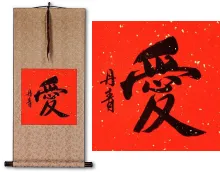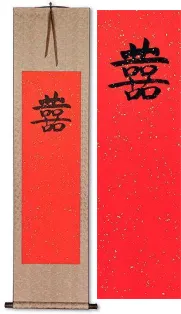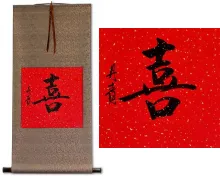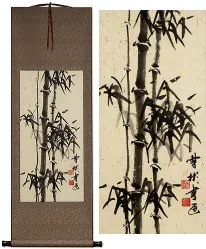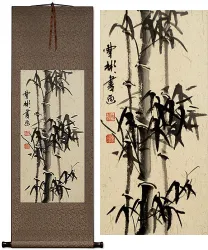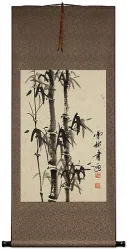Many custom options...
And formats...

Not what you want?
Try other similar-meaning words, fewer words, or just one word.
Black Red Black Red in Chinese / Japanese...
Buy a Black Red Black Red calligraphy wall scroll here!
Personalize your custom “Black Red Black Red” project by clicking the button next to your favorite “Black Red Black Red” title below...
Just as Liquor Turns a Face Red, Gold Turns a Heart Black
白酒紅人面黃金黑世心 literally says: [Just as] white liquor makes people's faces turn red, [So] yellow gold makes people's hearts turn black.
This is a warning about the nature of greed. The suggestion is that one who lusts for gold and riches will eventually have a black heart (or become a heartless greedy bastard). As a wall scroll, this is a reminder and warning to keep yourself from following the greedy path.
Goldfish
金魚 is the title for goldfish in Chinese and Japanese.
There was a time in ancient China when only the Emperor could possess the actual yellow-gold colored fish. This is why alternate coloration such as orange, black, red, and white was bred. Many believe this is why colors other than yellow-gold are more common for “goldfish” in pet shops today.
Demon / Raksha
羅剎 is the Chinese version of demon that comes from the ancient Sanskrit word raksha, raksasa (rākṣasa), raksas (rakṣas), or raksasi (rākṣasī).
This title regards malignant spirits and demons. These demons are described in ancient texts as terrifying, with black bodies, red hair, and green eyes, and as devourers of men.![]() FYI: Sometimes the second character is written in the form shown to the right.
FYI: Sometimes the second character is written in the form shown to the right.
This in-stock artwork might be what you are looking for, and ships right away...
Gallery Price: $106.00
Your Price: $58.88
Gallery Price: $108.00
Your Price: $59.88
Gallery Price: $65.00
Your Price: $39.88
Gallery Price: $90.00
Your Price: $49.88
Gallery Price: $65.00
Your Price: $39.88
Gallery Price: $90.00
Your Price: $49.88
Not the results for black red black red that you were looking for?
Below are some entries from our dictionary that may match your black red black red search...
| Characters If shown, 2nd row is Simp. Chinese |
Pronunciation Romanization |
Simple Dictionary Definition |
地獄 地狱 see styles |
dì yù di4 yu4 ti yü jigoku じごく |
More info & calligraphy: Hell(1) {Buddh} hell realm; Naraka; (2) {Christn} Hell; (3) hell; misery; nightmare; inferno; (4) place where a volcano or hot springs constantly spew smoke or steam; (place-name) Jigoku naraka, 捺落迦 (or 那落迦) ; niraya 泥犂; explained by 不樂 joyless; 可厭 disgusting, hateful; 苦具, 苦器 means of suffering; if 地獄 earth-prison; 冥府 the shades, or departments of darkness. Earth-prison is generally intp. as hell or the hells; it may also be termed purgatory; one of the six gati or ways of transmigration. The hells are divided into three classes: I. Central, or radical, 根本地獄 consisting of (1) The eight hot hells. These were the original hells of primitive Buddhism, and are supposed to be located umder the southern continent Jambudvīpa 瞻部州, 500 yojanas below the surface. (a) 等活 or 更活 Saṃjīva, rebirth, where after many kinds of suffering a cold wind blows over the soul and returns it to this life as it was before, hence the name 等活. (b) 黑繩 Kaslasūtra, where the sufferer is bound with black chains and chopped or sawn asunder. (c) 線合; 衆合; 堆壓 Saṃghāta, where are multitudes of implements of torture, or the falling of mountains upon the sufferer. (d) 號呌; 呼呼; 叫喚 Raurava, hell of wailing. (e) 大呌; 大號呌; 大呼 Mahāraurava, hell of great wailing. (f) 炎熱; 燒炙 Tapana, hell of fames and burning. (g) 大熱; 大燒炙; 大炎熱 Pratāpana, hell of molten lead. (h) 無間; 河鼻旨; 阿惟越致; 阿毗至; 阿鼻; 阿毗 Avīci, unintermitted suffering, where sinners die and are reborn to suffer without interval. (2) The eight cold hells 八寒地獄. (a) 頞浮陀地獄 Arbuda, where the cold causes blisters. (b) 尼刺部陀 Nirarbuda, colder still causing the blisters to burst. (c) 頞哳吒; 阿吒吒 Atata, where this is the only possible sound from frozen lips. (d) 臛臛婆; 阿波波 Hahava or Apapa, where it is so cold that only this sound can be uttered. (e) 虎虎婆 Hāhādhara or Huhuva, where only this sound can be uttered. (f) 嗢鉢羅; 鬱鉢羅 (or 優鉢羅) Utpala, or 尼羅鳥 (or 漚) 鉢羅 Nīlotpala, where the skin is frozen like blue lotus buds. (g) 鉢特摩 Padma, where the skin is frozen and bursts open like red lotus buds. (h) 摩訶鉢特摩 Mahāpadma, ditto like great red lotus buds. Somewhat different names are also given. Cf. 倶舍論 8; 智度論 16; 涅槃經 11. II. The secondary hells are called 近邊地獄 adjacent hells or 十六遊增 each of its four sides, opening from each such door are four adjacent hells, in all sixteen; thus with the original eight there are 136. A list of eighteen hells is given in the 十八泥梨經. III. A third class is called the 孤地獄 (獨地獄) Lokāntarika, or isolated hells in mountains, deserts, below the earth and above it. Eitel says in regard to the eight hot hells that they range 'one beneath the other in tiers which begin at a depth of 11,900 yojanas and reach to a depth of 40,000 yojanas'. The cold hells are under 'the two Tchahavālas and range shaft-like one below the other, but so that this shaft is gradually widening to the fourth hell and then narrowing itself again so that the first and last hell have the shortest, those in the centre the longest diameter'. 'Every universe has the same number of hells, ' but 'the northern continent has no hell whatever, the two continents east and west of Meru have only small Lokāntarika hells... whilst all the other hells are required for the inhabitants of the southern continent '. It may be noted that the purpose of these hells is definitely punitive, as well as purgatorial. Yama is the judge and ruler, assisted by eighteen officers and a host of demons, who order or administer the various degrees of torture. 'His sister performs the same duties with regard to female criminals, ' and it may be mentioned that the Chinese have added the 血盆池 Lake of the bloody bath, or 'placenta tank' for women who die in childbirth. Release from the hells is in the power of the monks by tantric means. |
不動明王 不动明王 see styles |
bù dòng míng wáng bu4 dong4 ming2 wang2 pu tung ming wang fudoumyouou / fudomyoo ふどうみょうおう |
More info & calligraphy: Fudo Myo-o / Wisdom King不動尊 Aryacalanatha 阿奢羅曩 tr. 不動尊 and 無動尊 and Acalaceta, 阿奢囉逝吒 tr. 不動使者. The mouthpiece or messenger, e. g. the Mercury, of the Buddhas; and the chief of the five Ming Wang. He is regarded as the third person in the Vairocana trinity. He has a fierce mien overawing all evil spirits. He is said to have attained to Buddhahood, but also still to retain his position with Vairocana. He has many descriptive titles, e. g. 無量力神通無動者; 不動忿怒王, etc. Five different verbal signs are given to him. He carries a sharp wisdom-sword, a noose, a thunder-bolt. The colour of his images is various—black, blue, purple. He has a youthful appearance; his hair falls over his left shoulder; he stands or sits on a rock; left eye closed; mouth shut, teeth gripping upper lip, wrinkled forehead, seven locks of hair, full-bodied, A second representation is with four faces and four arms, angry mien, protruding teeth, with fames around him. A third with necklaces. A fourth, red, seated on a rock, fames, trident, etc. There are other forms. He has fourteen distinguishing symbols, and many dharanis associated with the realm of fire, of saving those in distress, and of wisdom. He has two messengers 二童子 Kimkara 矜羯羅 and Cetaka 制吒迦, and, including these, a group of eight messengers 八大童子 each with image, symbol, word-sign, etc. Cf. 不動佛. |
五彩 see styles |
wǔ cǎi wu3 cai3 wu ts`ai wu tsai gosai ごさい |
five (main) colors (white, black, red, yellow, and blue); multicolored the five colours: green, yellow, red, white and black; the five colors; five-coloured porcelain; five-colored porcelain; (female given name) Saaya |
五色 see styles |
wǔ sè wu3 se4 wu se goshiki; goshoku ごしき; ごしょく |
multicolored; the rainbow; garish (1) five colors (usu. red, blue, yellow, white and black); five colours; (can be adjective with の) (2) many kinds; varied; (3) (See 瓜) melon; gourd; (place-name, surname) Goshiki The five primary colors, also called 五正色 (or 五大色): 靑 blue, 黃 yellow, 赤 red, 白 white, 黑 black. The 五間色 or compound colors are 緋 crimson, 紅, scarlet, 紫 purple, 綠 green, 磂黃 brown. The two sets correspond to the cardinal points as follows: east, blue and green; west, white, and crimson; south, red and scarlet; north, black and purple; and center, yellow and brown. The five are permutated in various ways to represent various ideas. |
仰韶 see styles |
yǎng sháo yang3 shao2 yang shao |
Yangshao culture (archaeological period with red and black pottery) |
四輪 四轮 see styles |
sì lún si4 lun2 ssu lun yonrin よんりん |
(can be adjective with の) four-wheeled The four wheels or circles: (1) 大地四輪 the four on which the earth rests, wind (or air), water, metal, and space. (2) Four images with wheels, yellow associated with metal or gold, white with water, red with fire, and black with wind. (3) The four dhyāni-buddhas, 金剛輪 Akṣobhya; 寳輪 Ratnasaṃbhava; 法輪 Amitābha; 羯磨輪 Amoghasiddhi. (4) Also the four metals, gold, silver, copper, iron, of the cakravartin kings. |
柄樽 see styles |
edaru えだる |
(See 酒樽) red and black lacquered sake cask with horn-like handles, used for ceremonies |
玄色 see styles |
xuán sè xuan2 se4 hsüan se |
black (without gloss); black with a hint of red in it |
紅樹 红树 see styles |
hóng shù hong2 shu4 hung shu kouju / koju こうじゅ |
red mangrove (Rhizophora mangle); CL:棵[ke1] (1) mangrove (esp. the black mangrove, Bruguiera gymnorrhiza); (2) tree with red leaves or flowers; (given name) Kōju |
羅刹 罗刹 see styles |
luó chà luo2 cha4 lo ch`a lo cha rasetsu らせつ |
rakshasa (san: rāksasa); man-eating demon in Hinduism and Buddhism; (female given name) Rasetsu (羅刹姿) rākṣasa, also羅叉娑; from rakṣas, harm, injuring. Malignant spirits, demons; sometimes considered inferior to yakṣas, sometimes similar. Their place of abode was Laṅkā in Ceylon, where they are described as the original inhabitants, anthropophagi, once the terror of shipwrecked mariners; also described as the barbarian races of ancient India. As demons they are described as terrifying, with black bodies, red hair, green eyes, devourers of men. |
舍利 see styles |
shè lì she4 li4 she li shari |
ashes after cremation; Buddhist relics (Sanskirt: sarira) (1) śārī, śārikā; a bird able to talk, intp. variously, but, M. W. says the mynah. Śārikā was the name of Śāriputra's mother, because her eyes were bright and clever like those of a mynah; there are other interpretation (2) śarīra(m). 設利羅 (or 室利羅); 實利; 攝 M004215 藍 Relics or ashes left after the cremation of a buddha or saint; placed in stupas and worhipped. The white represent bones; the black, hair; and the red, flesh. Also called dhātu-śarīra or dharma-śarīra. The body, a dead body. The body looked upon as dead by reason of obedience to the discipline, meditation, and wisdom. The Lotus Sutra and other sutras are counted as relics, Śākyamuni's relics are said to have amounted to 八斛四斗 84 pecks, for which Aśoka is reputed to have built in one day 84,000 stupas; but other figures are also given. śarīra is also intp. by grains of rice, etc., and by rice as food. |
五大色 see styles |
wǔ dà sè wu3 da4 se4 wu ta se go daishiki |
The five chief colours— yellow for earth, white for water, red for fire, black for wind, azure for space (or the sky). Some say white for wind and black for water. |
五輪觀 五轮观 see styles |
wǔ lún guān wu3 lun2 guan1 wu lun kuan gorin kan |
五輪三摩地 A meditation of the esoteric school on the five elements, earth, water, fire, air, and space, with their germ-words, their forms (i. e. square, round, triangular, half-moon, and spherical), and their colors (i. e. yellow, white, red, black, and blue). The five wheels also represent the Five Dhyāni-Buddhas, v. 五智. The object is that 五輪成身 the individual may be united with the five Buddhas, or Vairocana. |
五轉色 五转色 see styles |
wǔ zhuǎn sè wu3 zhuan3 se4 wu chuan se go tenjiki |
The above five developments are given the colors respectively of yellow, red, white, black, and blue (or green), each color being symbolic, e. g. yellow of Vairocana, red of Mañjuśrī, etc. |
赤黒木 see styles |
akakurogi あかくろぎ |
{comp} red-black tree; self-balancing binary search tree |
五根色: see styles |
wǔ gēn wu3 gen1 wu ken |
faith, white; zeal, red; memory yellow; meditation, blue; and wisdom, black. These are represented inter alia in the 五色線 (or 五色縷, or 五色綖, or 五色繩) the five-colored emblematic cord; this cord is also a brahman's sign worn on the shoulder and forbidden by the Buddha. |
仰韶文化 see styles |
yǎng sháo wén huà yang3 shao2 wen2 hua4 yang shao wen hua |
Yangshao neolithic culture from the central Yellow river basin, with red and black pottery |
波羅奢華 波罗奢华 see styles |
bō luó shē huā bo1 luo2 she1 hua1 po lo she hua harashake |
palāśa; a leaf, petal, foliage; the blossom of the Butea frondosa, a tree with red flowers, whose sap is used for dye; said to be black before sunrise, red during the day, and yellow after sunset. |
不分青紅皂白 不分青红皂白 see styles |
bù fēn qīng hóng zào bái bu4 fen1 qing1 hong2 zao4 bai2 pu fen ch`ing hung tsao pai pu fen ching hung tsao pai |
not distinguishing red-green or black-white (idiom); not to distinguish between right and wrong |
不問青紅皂白 不问青红皂白 see styles |
bù wèn qīng hóng zào bái bu4 wen4 qing1 hong2 zao4 bai2 pu wen ch`ing hung tsao pai pu wen ching hung tsao pai |
not distinguishing red-green or black-white (idiom); not to distinguish between right and wrong |
赤また黒また see styles |
akamatakuromata; akamatakuromata あかまたくろまた; アカマタクロマタ |
(kana only) red-masked and black-masked gods (folk belief of the Yaeyama Islands); harvest festival celebrating these gods (held in the 6th lunar month) |
アカマタクロマタ see styles |
akamatakuromata アカマタクロマタ |
(kana only) red-masked and black-masked gods (folk belief of the Yaeyama Islands); harvest festival celebrating these gods (held in the 6th lunar month) |
近朱者赤,近墨者黑 see styles |
jìn zhū zhě chì , jìn mò zhě hēi jin4 zhu1 zhe3 chi4 , jin4 mo4 zhe3 hei1 chin chu che ch`ih , chin mo che hei chin chu che chih , chin mo che hei |
those who handle cinnabar are stained red; those who work with ink are stained black (idiom); you are the product of your environment |
ブラックサージャンフィッシュ see styles |
burakkusaajanfisshu / burakkusajanfisshu ブラックサージャンフィッシュ |
black surgeonfish (Acanthurus gahhm, species of tang endemic to the Red Sea and the Gulf of Aden in the western Indian Ocean) |
ブラックサージョンフィッシュ see styles |
burakkusaajonfisshu / burakkusajonfisshu ブラックサージョンフィッシュ |
black surgeonfish (Acanthurus gahhm, species of tang endemic to the Red Sea and the Gulf of Aden in the western Indian Ocean) |
レッドテールブラックシャーク see styles |
reddoteeruburakkushaaku / reddoteeruburakkushaku レッドテールブラックシャーク |
red-tailed black shark (Epalzeorhynchos bicolor) |
ブラック・サージャンフィッシュ see styles |
burakku saajanfisshu / burakku sajanfisshu ブラック・サージャンフィッシュ |
black surgeonfish (Acanthurus gahhm, species of tang endemic to the Red Sea and the Gulf of Aden in the western Indian Ocean) |
レッドテール・ブラック・シャーク see styles |
reddoteeru burakku shaaku / reddoteeru burakku shaku レッドテール・ブラック・シャーク |
red-tailed black shark (Epalzeorhynchos bicolor) |
Variations: |
reddoteeruburakkushaaku; reddoteeru burakku shaaku / reddoteeruburakkushaku; reddoteeru burakku shaku レッドテールブラックシャーク; レッドテール・ブラック・シャーク |
red-tailed black shark (Epalzeorhynchos bicolor) |
Variations: |
burakkusaajonfisshu; burakkusaajanfisshu; burakku saajanfisshu / burakkusajonfisshu; burakkusajanfisshu; burakku sajanfisshu ブラックサージョンフィッシュ; ブラックサージャンフィッシュ; ブラック・サージャンフィッシュ |
black surgeonfish (Acanthurus gahhm, species of tang endemic to the Red Sea and the Gulf of Aden in the western Indian Ocean) |
Click here for more black red black red results from our dictionary
The following table may be helpful for those studying Chinese or Japanese...
| Title | Characters | Romaji (Romanized Japanese) | Various forms of Romanized Chinese | |
| Just as Liquor Turns a Face Red, Gold Turns a Heart Black | 白酒紅人面黃金黑世心 白酒红人面黄金黑世心 | bái jiǔ hóng rén miàn huáng jīn hēi shì xīn bai2 jiu3 hong2 ren2 mian4 huang2 jin1 hei1 shi4 xin1 bai jiu hong ren mian huang jin hei shi xin | pai chiu hung jen mien huang chin hei shih hsin | |
| Goldfish | 金魚 金鱼 | kin gyo / kingyo | jīn yú / jin1 yu2 / jin yu / jinyu | chin yü / chinyü |
| Demon Raksha | 羅剎 / 羅刹 罗刹 | luó chà / luo2 cha4 / luo cha / luocha | lo ch`a / locha / lo cha | |
| In some entries above you will see that characters have different versions above and below a line. In these cases, the characters above the line are Traditional Chinese, while the ones below are Simplified Chinese. | ||||
Successful Chinese Character and Japanese Kanji calligraphy searches within the last few hours...

